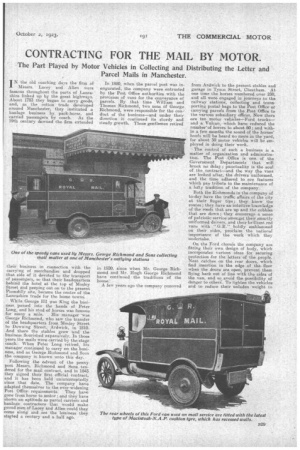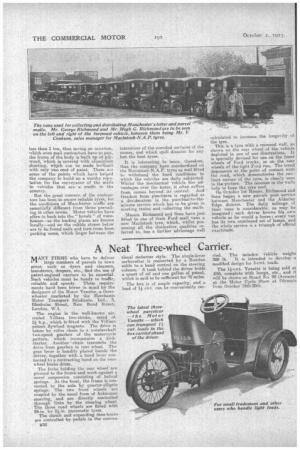CONTRACTING FOR THE MAIL BY MOTOR.
Page 15

Page 16

If you've noticed an error in this article please click here to report it so we can fix it.
The Part Played by Motor Vehicles in Collecting and Distributing the Letter and Parcel Mails in Manchester.
I X the old coaching days the firm ,of
Messrs. Lacey and Allen Were famous throughout the parts of Lancashire linked up by the great highways. About 1783 they began to carry goods, and, as the cotton trade developed around Manchester, they instituted a haulage business by pack-horse, and carried passengers by coach. As the 19th century dawned the firm extended their business in connection with the carrying of merchandise and dropped that side of it devoted to the transport of passengers, so that their headquarters behind the hotel at the top of Mosley Street and peeping out on to the present Piccadilly site, became the centre of the Lancashire trade for the home towns.
While George III vas King the business passed into the hands of. Peter Long, and his stud of horses was famous for many a mile. His manager was George Ikichmond, who saw the transfer of the headquarters from Mosley Street to Downing Street., Ard%vick, in 1810. And there the stables grew hod the business flourished expansively. In those years the mails were carried by the stage coach. When Peter Long retired, his manager continued to carry on the business, and as George Richmond and Sons the company is known unto this day.
Following the advent of the penny post Messrs. Richmond and Sons tendered for the mail contract., and in 1843 they signed their first official contract, and it has been held uninterruptedly . since that date. The company have adapted themselves to the ever-widening Post Office requirements. They have gone from horse to motor ; and they have shown an aptitude as parcel carriers and haulage contractors that would make proud men of Lacey and Allen could they come along and see the business they started a century and a half ago. In 1880, when the parcel post was inaugurated, the company were entrusted by the Post Office authorities with the provision of vans for the conveyance of parcels. By that time William and Thomas Richmond, two sons of George Richmond, were responsible for the con= duct of the business—and under their direction it continued its sturdy and steady growth. Those gentlemen retired in 1920, since when. Mr. George Richmond and Mr. Hugh George Richmond have continued the traditions of the house.
A few years ago the company removed
from Ardwick to the present stables and garage in Tyson Street, Oheetham. At one time the horses numbered over 230, and all were engaged in journeys to the railway stations, collecting and transporting postal bags to the Post Office or carryin,g parcels from the Post Office to the various subsidiary offices. Now there are ten motor vehicles—Ford trucks— and a Vulcan, -which have reduced the numbeeof horses to about 60; and within a few months the sound of the horses' hoofs will be beard no more in the yard, for about 30 motor vehicles will be employed in doing their work.
The control of such a business is a matter of organization and administration. The Post Office is one. of the Government Departments that will brook no delay ; punctuality is the soul of the contract—and the way the vans are looked after, the drivers uniformed, and the time adhered to ore features which pay tribute to the maintenance of a lofty tradition of the company.
Both the Richmonds in the company of to-day have the traffic affairs of the city at their finger tips ; they know the routes; they have an intuitive knowledge of the roods that are up and the cobbles that are down ; they encourage a sense of patriotic service amongst their smartly uniformed drivers, and their brilliant red vans with " G.R." boldly emblazoned on their sides, proclaim the national importance of the work which they undertake.
On the Ford chassis the company are fitting their own design of body, which incorporates various ideas for securing protection .for the letters of the people. Neat catches on the rear doors, which find insertion in the edge of the. floor when the doors are open1 prevent them flying back out of line with the sides of the van, and so avoid the possibility of danger to others'. To lighten the vehicles and to reduce their unladen weight to less than 1 ton, thus saving on taxation, which even mail contractors have to pay, the frame of the body is built up of plywood, Which /a covered with aluminium sheeting, which can he made brilliant. with only one coat of paint. These are some of the points which have helped the company to build up a worthy reputation for the conveyance of the mails in vehicles that are a credit, to the country.
But. the great concern of the contractors has been to secure reliable tyres, for the conditions of Manchester traffic are essentially different from those prevailing in other towns. Motor vehicles have often to back into the " hovels " of warehouses—as the loading places are known locally—and on the cobble stones below are to be found nails and torn irons from . packing cases, which linger between the interstices of the rounded surfaces of the stones, and which spell disaster for any but the best tyres.
It is interesting to learn, therefore, that the coMpany have standardized on the Macintosh-NAP. tyres as well fitted to withstand the hard conditions to .which the vehicles are daily subjected. Whilst the mechanical vehicle has advantages over the horse, it often suffers from causes beyond its control. And freedom from punctures is regarded as a desideratum in the punctual-to-theminute service which has to be given in meeting trains and collecting the mails.
Messrs. Richmond and Sons have just fitted to one of their Ford mail vans a new Macintosh tyre, which, whilst possessing all the distinctive qualities referred to, has a further advantage well calculated to increase the longevity of the tyre.
This is a tyre with a recessed wall, as shown on the rear wheel of the vehicle depicted in one of our illustrations. It is specially devised for use on the front wheels of Ford trucks, or on the rear wheels of the light Ford van. The tread depression at, the point of contact with the read,, which demonstrates the resilient nature of the tyre, is clearly seen in the picture. The recesses in the walls help to keep the .tyre cool.
On October 1st Messrs. Richmond and Sons began a new parcels post service between Manchester and the Alderley Edge district. The daily mileage of their vans is considerable, as may be imagined ; each driver knows his own vehicle as be would a horse ; every van has its Own numbered set of lamps, and the whole service is a triumph of official exactitude.
































